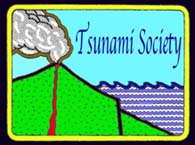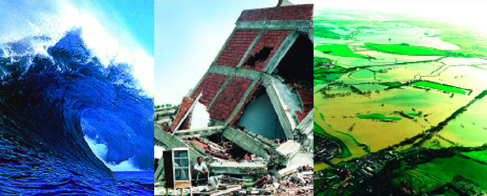Tsunami
Society
International
Journal
SCIENCE OF TSUNAMI HAZARDS
ISSUES - Year 2016
(Individual Papers and Entire Journals in PDF format)
( Because of file sizes, the journal and individual papers may take several minutes to
load. For faster viewing and downloading,
links to compressed PDF files are also provided. However, photos and graphics may not be of as high quality as those in uncompressed files).
Downloading the journal in uncopressed format may take 10 minutes or more.
VOLUME 35 Number 3 (November 2016)
Complete Journal - STHVol35N3Y2016.pdf- ( 34.3 MB, 124 pages) Compressed Journal - STHVol35N3Y2016c.pdf- ( 4.3 MB)
LANDSLIDE-TYPE TSUNAMI MODELLING BASED ON THE NAVIER-STOKES EQUATIONS
A.S. Kozelkov (1,2), A.A. Kurkin (2), E.N. Pelinovsky, (2-4),
E.S. Tyatyushkina (1), V.V. Kurulin (1), N.V. Tarasova( 1)
1) Russian Federal Nuclear Center, All-Russian Research Institute of Experimental Physics, Sarov, RUSSIA
2) Nizhny Novgorod State Technical University n.a. R. Alekseyev, Nizhny Novgorod, RUSSIA
3) Institute of Applied Physics, Nizhny Novgorod, RUSSIA
4) National Research University – Higher School of Economics, Moscow, RUSSIA
ABSTRACT
The paper presents a unified computing technology for all stages of landslide-type tsunami. The computing technology is
based on the numerical solution of the Navier – Stokes equations for multiphase flows. The method of numerical solution
of the Navier – Stokes equations uses a fully implicit algorithm. This algorithm removes stiff restrictions on the time
steps and allows simulating a tsunami propagation in arbitrarily large water basins. The basic sampling equation formulas,
coefficient types as well as the basic steps of the computational procedure are presented. The landslide is modeled by
a single phase with its density and viscosity, which is separated by the interface from water and air phases. A parallel
algorithm of the method implementation based on an algebraic multigrid method is proposed for the effective usage of
the method to calculate the tsunami in large water areas. The multigrid method of implementation is based on algorithms
of global level and cascading collection. These algorithms do not impose restrictions on the scale parallelization and
allow the use of the proposed technology in petaflop class systems. It shows the possibility of simulating all the stages
of the landslide-type tsunamis: generation, propagatioagrn and runup. The verification of the method is carried out by
using the tests provided by the experimental data. The mechanism of bathymetric data accounting and the technology of
constructing three-dimensional grid models are described. The results of the comparison with the non-linear dispersion
theory are presented for the historical tsunami that resulted from a volcanic eruption on the island of Montserrat,
the Caribbean. The results of this comparison are in good agreement.
ASSESSING LANDSLIDE-TSUNAMI HAZARD IN SUBMARINE CANYONS, USING THE COOK STRAIT CANYON SYSTEM AS AN EXAMPLE
William Power - GNS Science, 1 Fairway Drive, Avalon, Lower Hutt, New Zealand
Joshu Mountjoy - NIWA, 301 Evans Bay Parade, Hataitai, Wellington, New Zealand
Emily Lane - NIWA, 10 Kyle Street, Riccarton, Christchurch, New Zealand
Stephane Popinet - Université Pierre et Marie Curie, 4 Place Jussieu, 75005 Paris, France
Xiaoming Wang - GNS Science, 1 Fairway Drive, Avalon, Lower Hutt, New Zealand
ABSTRACT
Tsunami generated by submarine landslides are now recognised as an important hazard, following several historical events. Submarine landslides can occur in a variety of settings such as on continental slopes, volcanic slopes, and submerged canyons and fjords. While significant progress has been made in understanding tsunami generation processes on open slopes, the problem of tsunami generation by landslides within submarine canyons has received less attention. In this paper we examine the tsunami hazard posed by submarine landslides in the Cook Strait canyon system, near Wellington, New Zealand. Understanding of the hazard posed by this tsunami source has practical value because of its proximity to a populated coast. Our studies also provide general results highlighting the differences between tsunami generation on open coasts and tsunami generation within canyons. Geotechnical and geological studies of the Cook Strait region reveal evidence for many large landslide scars in the canyon walls, these are interpreted to be failures of consolidated material which descend the slopes on the sides of the canyon. Scouring of the base of the canyon slopes by strong tidal currents is believed to be an important process in bringing slopes to the point of failure, with most large failures expected to occur during earthquake shaking. We present the results of computer simulations of landslide failures using simplified canyon geometries represented in either 2D (vertical slice) or 3D. These simulations were made using Gerris, an adaptive-grid fluid dynamics solver. A key finding is that the sudden deceleration of the landslide material after reaching the canyon floor, leads to larger amplitude waves in the back-propagation direction (i.e. in the opposite direction to the initial landslide motion).
FEATURES AND PROBLEMS WITH HISTORICAL GREAT EARTHQUAKES AND TSUNAMIS IN THE MEDITERRANEAN SEA
1 Lobkovsky L., 2 Mazova R., 2 Tyuntyaev S.,2 Remizov I..
1P.P. Shirshov Institute of Oceanology, Russian Academy of Sciences, Moscow, Russia
2R.E.Alekseev Nizhny Novgorod State Technical University, Nizhny Novgorod, Russia
ABSTRACT
The present study examines the historical earthquakes and tsunamis of 21 July 365 and of 9 February 1948 in the Eastern Mediterranean Sea. Numerical simulations were performed for the tsunamis generated by underwater seismic sources in frames of the keyboard model, as well as for their propagation in the Mediterranean Sea basin. Similarly examined were three different types of seismic sources at the same localization near the Island of Crete for the earthquake of 21 July 365, and of two different types of seismic sources for the earthquake of 9 February 1948 near the Island of Karpathos. For each scenario, the tsunami wave field characteristics from the earthquake source to coastal zones in Mediterranean Sea’s basin were obtained and histograms were constructed showing the distribution of maximum tsunami wave heights, along a 5-m isobath. Comparison of tsunami wave characteristics for all the above mentioned scenarios, demonstrates that underwater earthquakes with magnitude M > 7 in the Eastern Mediterranean Sea basin, can generate waves with coastal runup up to 9 m.
KEYWORDS: Mediterranean Region, Great Historical Tsunamigenic Earthquakes, Seismic Source, Tsunami Generation, Tsunami Propagation, And Numerical Simulation
ENHANCED VERTICAL EVACUATION APPLICATION WITH GEOMATIC TOOLS FOR TSUNAMIS IN SALINAS, ECUADOR
Andres Sebastian Matheus Medina, Mario Cruz D´Howitt, Oswaldo Padilla Almeida, Theofilos Toulkeridis* and Ana Gabriela Haro
Universidad de las Fuerzas Armadas ESPE, Sangolquí, Ecuador
ABSTRACT
Tsunami hazards are more than evident in the Pacific coast of Ecuador, but especially on its westernmost Peninsula called Salinas. As the potential impact time is relatively short for the public to reach natural high ground or at least leave the tsunami inundation area, a different approach to rescue lives has been applied with geomatic tools. The buildings inside the tsunami hazard zone have been first evaluated for their seismic resistance. Those buildings, which have been proven to withstand a seismic event, have been chosen to serve as elevated safe zones for a subsequent vertical tsunami evacuation. The used geographic tools allowed reducing time spans between initial evacuation points towards safe zones inside the tsunami inundation areas. The results of this study demonstrate the efficiency of vertical tsunami evacuation in a highly populated and visited touristic area in coastal Ecuador, as in Salinas appears a relatively high percentage of the population to far from shelters or elevated safe zones during a short-time impact of a tsunami.
KEYWORDS: Tsunami, Seismic resistant buildings, Numerical modeling, Vertical Evacuation, Ecuador
BATHYMETRIC SOUNDING by REMOTE SENSING Using ELECTROMAGNETIC RADIATION
Frank C Lin 1, George Pararas-Carayannis 1, Piyarat Silapasuphakornwong 2
1 Tsunami Society International, Honolulu, Hawaii 96815, USA
2 Human Media Research Center, Kanagawa Institute of Technology, Kanagawa 243-0292, Japan
ABSTRACT
We describe a novel modus operandi to survey the ocean floor. We utilize the eruption of submarine volcanoes as a light source. The electromagnetic radiation emitted by such eruptions illuminate the ocean floor and thus provides information about the bathymetric topology, and a geostationary satellite can monitor this. Since the wavelength of the electromagnetic radiation is many orders of magnitude shorter than that of the acoustic wave, finer details of the bathymetric features can be obtained. We show that a topographical representation of the seabed can be derived from the Signal Diagram by a simple transformation (a mirror reflection). In this case the radiation is emitted by water molecules stimulated by the heat of the volcanic eruption, in contradistinction to the case of tsunami radiation, where the water molecules are stimulated by mutual collisions at high speed. We give two examples: Illapel, Chile and Chichi-shima, Japan. We have also shown that water molecules in the ocean, when stimulated by the heat of submarine volcanic eruption, will emit infrared radiation.
KEYWORDS: Tsunami Radiation, Signal Diagram, Remote Sensing, Infrared Topography, Illapel, Chile, Chichi-Shima, Japan.
Estimation of Coseismic Deformation from the Sea Level Measurements during the Mw 7.8 Earthquake of 13 Nov 2016 in New Zealand
A. Annunziato - European Commission - Joint Research Centre (JRC), Ispra, italy
Letter to the Editor, 15 Nov 2016
Copyright © 2016 - TSUNAMI SOCIETY INTERNATIONAL
WWW.TSUNAMISOCIETY.ORG
__________________________________________________
VOLUME 35 Number 2 (May 2016)
Complete Journal - STHVol35N2Y2016.pdf- ( 14.7 MB, 72 pages) Compressed Journal - STHVol35N2Y2016c.pdf- ( 2.8 MB)
BENCHMARK SOLUTIONS FOR TSUNAMI WAVE FRONTS AND RAYS. PART 1: SLOPING BOTTOM TOPOGRAPHY
Andrey G. Marchuk - Institute of Computational Mathematics and Mathematical Geophysics, Novosibirsk, RUSSIA
ABSTRACT
In this paper, the kinematics of tsunami wave rays and fronts over an uneven bottom are studied. A formula for the wave height along a ray tube is obtained. An exact analytical solution for wave rays and fronts over a sloping bottom is derived. This solution makes possible to determine a tsunami wave height in an area with a sloping bottom from the initial source in the ray approximation. The distribution of wave-height maxima calculated in an area with a sloping bottom is compared to that obtained with a shallow-water model.
Keywords: tsunami, wave kinematics, wave ray and front, exact solutions for sloping bottom
THE TROBRIAND ISLANDS EARTHQUAKE AND TSUNAMI, 6 MARCH 1895
Horst Letz - GeoForschungZentrum Potsdam, GERMANY,
Kevin McCue - Australian Seismological Centre, Canberra, AUSTRALIA,
Ian Ripper - Brisbane Queensland AUSTRALIA.
ABSTRACT
An earthquake and tsunami struck the Trobriand Islands in March 1895 causing at least 30 deaths but until now the location and magnitude of the earthquake were quite uncertain. We have searched British and German colonial literature of the time to refine both parameters of Everingham’s original estimates. Our magnitude of 7.3±0.3 and location at (8.4°S, 150.1°E) compare well with Everingham’s magnitude 7-8 and (9°S, 151°E). Whilst the earthquake seems to be associated with the Trobriand Trench, very few others have occurred there since modern seismographs were deployed in the mid-1960s, certainly none of magnitude 7 or more, none with a thrust mechanism and none that have generated a destructive tsunami. We compare this earthquake and tsunami with the 1998 Sissano Lagoon earthquake, for which we have drawn an isoseismal map, and briefly discuss the implications for tectonic interpretation and hazard assessment.
METHODS OF TSUNAMI DETECTION AND OF POST-TSUNAMI SURVEYS
Kurkin - Nizhny Novgorod State Technical University, Nizhny Novgorod, RUSSIA
V. Belyakov - Nizhny Novgorod State Technical University, Nizhny Novgorod, RUSSIA
V. Makarov - Nizhny Novgorod State Technical University, Nizhny Novgorod, RUSSIA
D. Zeziulin - Nizhny Novgorod State Technical University, Nizhny Novgorod, RUSSIA
E. Pelinovsky - Nizhny Novgorod State Technical University, Nizhny Novgorod,, Institute of Applied Physics, Nizhny Novgorod; . National Research University ; Higher School of Economics, Nizhny Novgorod, RUSSIA
ABSTRACT
In our paper we describe some of the methods of the last 25 years which have been used extensively to examine and register tsunami traces - particularly by satellite imaging of coastal zones before and after a tsunami has struck, thus assessing quickly the extent of coastal inundation over large areas without the need of a site visit. Nearly all countries bordering oceans, seas and bodies of water have established digital systems of water level registration in the range of tsunami waves. In this article we describe methods of tsunami detection and runup measurements, some based on our own participation in post-tsunami surveys. Also, we discuss the possibility of using robotic systems to survey tsunami traces in hard-to- reach places.
TSUNAMI DISPERSION SENSITIVITY TO SEISMIC SOURCE PARAMETERS
Oleg Igorevich Gusev, Sofya Alexandrovna Beisel
Institute of Computational Technologies of SB RAS, 6 Acad. Lavrentjev Avenue, 630090 Novosibirsk, RUSSIA
ABSTRACT
The study focuses on the sensitivity of frequency dispersion effects to the form of initial surface elevation of seismic tsunami source. We vary such parameters of the source as rupture depth, dip-angle and rake-angle. Some variations in magnitude and strike angle are considered. The fully nonlinear dispersive model on a rotating sphere is used for wave propagation simulations. The main feature of the algorithm is the splitting of initial system on two subproblems of elliptic and hyperbolic type, which allows implementation of well-suitable numerical methods for them. The dispersive effects are estimated through differences between computations with the dispersive and nondispersive models. We consider an idealized test with a constant depth, a model basin for near-field tsunami simulations and a realistic scenario. Our computations show that the dispersion effects are strongly sensitive to the rupture depth and the dip-angle variations. Waves generated by sources with lager magnitude may be even more affected by dispersion.
Keywords: seismic source, tsunami propagation, frequency dispersion, fully nonlinear dispersive model, rotating sphere, numerical modelling.
Copyright © 2016 - TSUNAMI SOCIETY INTERNATIONAL
WWW.TSUNAMISOCIETY.ORG
-------------------------------------------------------------------------------------------------------------------------------------------
VOLUME 35 Number 1 (January 2016)
Complete Journal - STHVol35N1Y2016.pdf- ( 6.8 MB, 33 pages) 
DETECTION OF TSUNAMI RADIATION AT ILLAPEL, DHILE ON 2015-9-16 BY REMOTE SENSING
Frank C Lin, Kingkarn Sookhanaphibarn, Worawat Choensawat and George Pararas-Carayannis*
Multimedia Intelligent Technology Laboratory, School of Science and Technology, Bangkok University, Rama 4 Rd, Khlong Toei, Bangkok 10110, Thailand
* Tsunami Society International, Honolulu, Hawaii 96815, USA
ABSTRACT
We have detected the Tsunami Radiation generated by the 8.3 magnitude seaquake at Illapel, Chile on 2015-9-16 at the following wavelengths: 3.9 µm, 6.5 µm, 10.7 µm, and 13.3 µm. No radiation is detected at 0.63 µm, which is in the visible spectrum. The Tsunami Signals that we have observed did not decay within 44 minutes. From the satellite the Peru-Chilean Trench is visible in infrared space. In order to facilitate research in this field we attach the MATLAB code in an Appendix.
Keywords: Tsunami Radiation, Tsunami Signal, Remote Sensing, Tsunami Decay, Illapel
Chile
THE ECONOMIC EVALUATION AND SIGNIFICANCE OF AN EARLY RELOCATION VERSUS COMPLETE DESTRUCTION BY A POTENTIAL TSUNAMI OF A COASTAL CITY IN ECUADOR
Fabian Rodriguez, Mario Cruz D´Howitt, Theofilos Toulkeridis*, Rodolfo Salazar, Gioconda Elizabeth Ramos Romero, Veleria Alejandra Recalde Moya and Oswaldo Padilla
Universidad de las Fuerzas Armadas ESPE,Sangolquí, Ecuador
ABSTRACT
The coastal part of continental Ecuador is highly vulnerable for tsunami hazards as shown in the past two centuries. In order to avoid future devastating destructions in a given part in the coastline, we have estimated the economic effects of a potential future tsunami for one small Pacific town in Ecuador in order to analyze such potential cost of damages and compare it with a proposed resettlement value of the entire town. In past, most of the known resettlement projects have been realized as result of a natural disaster or a planning infrastructure such as hydro-electrical plants. Yet, in this study, we have considered to propose to policy makers and other authorities to take into account that a resettlement plan should be realized prior an impact by one the most deadly natural hazard. The results include four different scenarios of economic losses as a result of a potential tsunami, using human losses as the only variable that vary. Potential economic losses vary from 441 US$ up to 620 US$ millions, when compared to a potential resettlement and associated costs based on the four scenarios. The B/C ratio is favorable to town resettlement as Government’s preventing policy favoring an intelligent reduction and prevention of vulnerability and loss of human life.
Key words: Tsunami, Economic loss, Resettlement, Prevention, Ecuador




